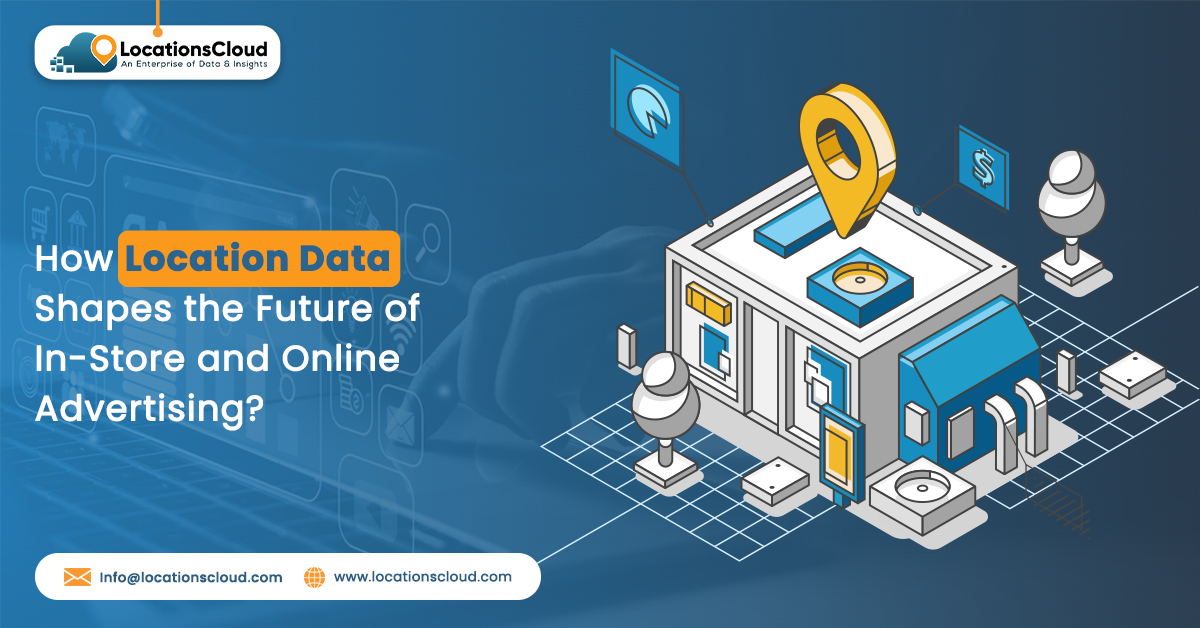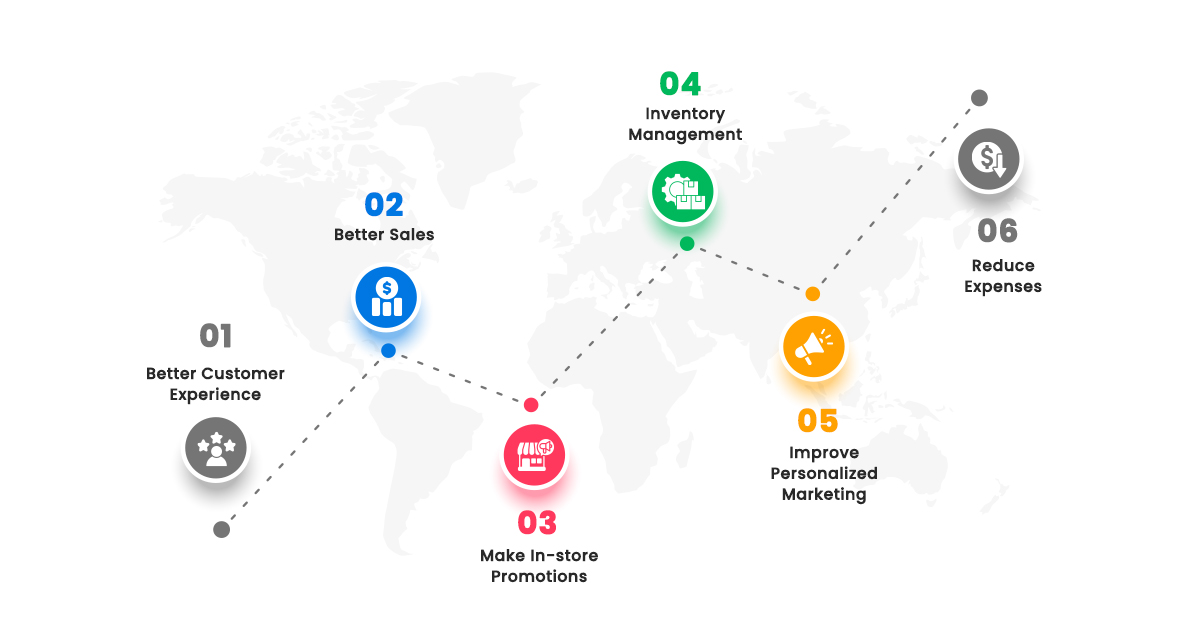
Location data represents the in-depth details identifying the physical location of commercial buildings, retail stores, and business presence. In today’s competitive era, location data has become essential for every business, especially retail stores.
Access to the latest and most accurate store location data helps business owners and analysts perform market research and analysis, make effective business decisions, build effective marketing strategies, and optimize overall business operations.
The combination of store location data and location intelligence helps monitor store inventory, product price, operational hours, current market trends, and more. Real-time and accurate details help businesses better serve customers and stay ahead of the competition.
How Location Data Works for Retail Stores?
The primary fundamentals of location data are to locate and showcase a store’s exact location using longitude and latitude. Moreover, it showcases the character of the business and provides detailed addresses to users.
Integrating store location data with a geospatial system delivers vital information such as POI data, Mobility data, demographic acumens, images, and other business information. The perfect blend of data integration with an analytics system helps analyze footfalls, competitors, trends, and more.
Retail stores can leverage location data in many ways. This blog will explain two inevitable uses of location data: in-store location and online advertising. These will heavily impact retail businesses and assist in enhancing business performance and increasing profit.
Understanding Location Data for In-Store Operations
Gone are the days when customers needed to ask in-store staff for assistance selecting items or paying for them. With the help of in-store location data, shoppers can complete the whole process automatically, and businesses can also reveal key insights to enhance customer experience and overall business profit.
Types of In-store Location Data Tracking
In-store location data monitors and analyzes customers’ movements and behaviors within a physical retail environment. This enables businesses to make data-driven decisions that can increase sales and customer satisfaction.
Geofencing
With the help of Geofencing, it is possible to connect directly with customers when they come near a particular geographic area of the store. Nowadays, stores can easily implement this with the help of GPS signals and Bluetooth.
While customers log in to the relevant app and consent to fetch their data, the application transmits the BT signals to the closest beacon. This process allows shops to have informative data regarding where they can find a particular product. Business owners will get data related to customer purchase behavior and can send notifications to customers based on their preferences.
Sensors
This advanced technology can help retailers identify where customers are in the store. Adding 3D sensors provides an aerial view of the limited area under the shop, and retailers can get key data related to a customer’s accurate journey from section to section.
As 3D sensors are expensive, retailers can use alternative technology called beam sensors. These sensors can notice movement and send signals to track a customer’s entry and exit. Due to its functional limitations, it cannot provide complete data but can deliver a count related to footfalls in a day.
Token Analytics
Another way to track customer location within a store is to track shopping carts. A small electronic device can be fixed on the carts, and it provides data related to where customers have moved during shopping. Though it helps to collect data, it is not enough to make precise predictions.
What are the Benefits of In-store Location Tracking?

Better Customer Experience
By collecting data related to customer’s store journeys and shopping behavior, retailers can identify which products are most popular and which are not, which areas require more attention, etc. This key data insight helps to optimize store design and uplift the customer experience.
Better Sales
By analyzing the collected data, stakeholders can build effective marketing strategies and send personalized suggestions to customers, which can help boost sales.
Make In-store Promotions Better
Customer tracking data can be a great source of improvement for store promotions. Store owners can also learn about popular products and how customers react to ongoing promotions.
Inventory Management
Based on the popularity of the products, management can monitor the inventory level and ensure that they never run out of stock.
Improve Personalized Marketing
Retailers can create tailored marketing campaigns to boost sales. They can use customer tracking data to generate email campaigns that suggest product recommendations based on customers’ shopping patterns.
Reduce Expenses
By optimizing overall store operations, retailers can cut unnecessary expenses. This ultimately assists them in providing diverse services at affordable rates.
How to Use Location Data for Digital Advertising?
Location-based digital advertising is becoming increasingly popular in promoting businesses in particular locations, especially in the retail industry.
Location data plays a vital role in the success of digital advertisement, where businesses target customers based on geolocation trends and requirements. This data lets retailers know their customer base, shopping patterns, competitor strategy, presence, and more. Digital advertising based on acquired precise location data can influence brand engagement, help increase the customer base and retention ratio, and improve market share in a specific area.
Geospatial advertising can be successfully conducted by collecting customer movement data using tools and technologies, including GPS, GIS, and IoT devices. Let’s explore the valuable use cases for running a successful digital advertising campaign based on precisely collected location data.
Use Cases of Location-Based Digital Advertising
Location-based digital advertising uses geolocation data to deliver targeted ads to consumers based on their current or past locations.
Create Detailed and Precise Identities
Location data assembles accurate information about customers, delivering details related to customer preferences. This information becomes useful for advertisers to create an identity that helps to make offers and ads more effective.
For example, retail stores can collect regular customers’ location data by tracking their activities before and after shopping. Marketers can create relevant ads promoting healthy food and drinks if customers visit a fitness club.
Identify Similar Customers
With the combination of location data and intelligence, retailers can identify customers and create segments with the same interests and shopping behavior. The creation of the same audience group allows marketers to send promotional messages directly to improve customer acquisition.
Connect with Competitors’ Customer
Retailers can gather location data of competitors’ customers and learn their shopping interests and behaviors. This dataset allows companies to reach customers of their targeted competitors. A competitive intelligence tool also helps a lot by providing data related to audiences, footfall, behavior analytics, and more.
Mobile Advertising
Mobile has become an inevitable medium for digital advertisement. With the help of real-time location data, marketers can deliver adequate and relevant offers directly to customers’ cell phones. SMS marketing can be effective as it helps communicate with consumers directly and quickly.
Marketers can use mobile ads on Google, send push notifications, and run ads through navigation and other apps. Utilizing these location-based mobile marketing strategies helps connect with consumers effectively and gain a competitive edge.
Location-Based Customer Segmentation
With the help of location data, businesses can create groups of customers based on different geolocations, such as country, state, city, or zip code.
Geofencing is used to create a virtual edge. When customers enter the area, a targeted promotion is delivered to their mobile device. For example, if customers enter the boundary created around the retail store, they will get a text message or push notification related to the promotion.
Geotargeting is part of geofencing but depends on add-on customer data like behavior and shopping interests. For example, if a new retail store launches with only vegan food, marketers can use geofencing to target the city area and geotargeting for the area and homes for promotions.
Geo-Targeting Social Media Advertisements
Location Data provides significant benefits for social media advertising campaigns. It helps businesses target and reach specific users. For example, a fast-food chain can run location-based social media ads for its new branch opening to connect with users within the city or area. Targeted area users can see the ads on their social media profiles and connect with the food chain via a given CTA.
Benefits of Location-Based Digital Advertising
According to a Factual report, more than 85% of digital marketers believe that location-based marketing campaigns help increase customer numbers and achieve higher ROI. Let’s have a look at what benefits location-based advertising delivers to the business.
Improvement in Finding Target
With the help of location data, businesses can reach out to consumers who can be their potential buyers. Retailers can pitch their products at the perfect time during customers’ buying processes. For example, a seasonal business can increase the sale of a particular item by targeting nearby communities within the decided geographical area.
Perfect Relevance
Location-data-based marketing helps deliver messages to the appropriate audience by choosing them based on their locations. For example, a local business only needs to target consumers within its service range. Hence, with the help of location data, it is possible to run the advertisement within a specific area.
Enhance Customer Engagement
Marketing activities done based on location data help to make a strong connection with the customers. Businesses can engage with the right audience and offer products that are highly relevant to their requirements. As a result, the customer interacts more with the brand and better engages with the business.
Improved Conversion Rate
Running a digital advertising campaign based on location-based data helps businesses target and reach the perfect audience. A successful location-based marketing campaign helps increase in-store footfall, engagement, and brand promotion, which results in a higher conversion rate and profit.
Important Insights
Location-based ads help retailers gain key data insights into customers’ behavior, choices, and purchase habits. They can also measure the business performance of targeted regions, understand customer demands, and meet their needs.
Conclusion
Retail businesses can attract customers and achieve a higher return on investment (ROI) by optimizing their marketing spend based on real-time, actionable insights. Location data is more than just a set of numbers or geo coordinates. It allows businesses to reveal critical information related to their customer buying behavior. Expert service providers like LocationsCloud can effectively do this to stay competitive. By knowing specific important points, advertisers can build effective marketing strategies that help retail businesses reach more relevant consumers and get higher ROI.


